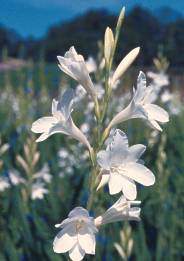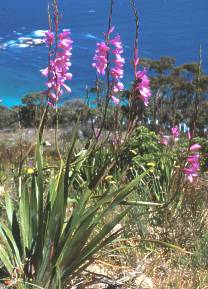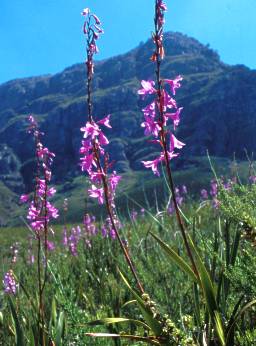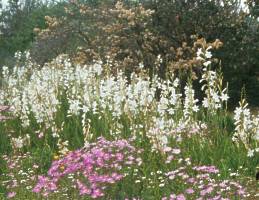Watsonia borbonica
Watsonia borbonica (Pourr.) Goldblatt
Family: Iridaceae
Common names: pink watsonia ( Eng. ); suurkanol, kanolpypie (Afr.)
Introduction
This magnificent bulbous plant with tall spikes of rose-pink, trumpet-shaped flowers makes a picturesque display, flowering for up to 4 or 5 weeks - a beautiful garden subject that needs little maintenance.
Description
Description
Watsonia borbonica is a tender to half-hardy herbaceous perennial that grows up to 2 m high. It is deciduous, growing during autumn-winter-spring and dying back after flowering in spring to early summer and remaining dormant during summer. The rootstock is a corm, 30-40 mm in diameter with grey-brown tunics. It bears upright fans of 5-6, up to 8 glossy, broad, sword-shaped leaves, 20-40 mm wide, that are one to two thirds as long as the flower spike. The margins of the leaves are without colour (hyaline) and moderately thickened.
The flowering stem usually bears two or more small bracts in the upper part, is usually branched and reaches up to 2 m in height. The flower is a spike, the main axis bearing up to 20 flowers and the branching (lateral) spikes up to 10 flowers. The flowers are large and showy, pale to deep pink to light purple, and faintly fragrant. The tepals have a darker midline, and a white streak at the base and very occasionally a plant is found where the whole tepal is white.
The flowers are zygomorphic, i.e. they can be divided into equal halves in one plane only. Flowering time is during late spring to early summer-from October to early December and sometimes into January. The fruit is an oblong capsule, more or less woody, sometimes widening at the apex, splitting to release winged seeds, 8-12 x 2.5 mm.
Conservation Status
Status
Based on the 1996 assessments and its distribution, the species is not threatened.
Distribution and habitat
Distribution description
Watsonia borbonica grows in the extreme southwest of the Western Cape, from Tulbagh southwards to the Cape Peninsula and eastwards to Bredasdorp. Its habitat is mainly rocky sandstone slopes or well-drained slopes of clay and granite, and sometimes in deep sandy soil at the foot of the mountains.
Derivation of name and historical aspects
History
The genus Watsonia was named by Philip Miller of Chelsea after his friend Sir William Watson (1715-1787), a London physician and naturalist. The species name borbonica means from the Ile de Bourbon, now Réunion, as it was mistakenly thought to originate from Réunion. In Australia and the USA, W. borbonica has become naturalized in some areas and is known as the Cape bugle lily or rosy watsonia.
The Afrikaans common name kanol is a phonetically corrupted version of the original Dutch word knol, meaning a corm, and is applied to many cormous species, although mainly to species of Watsonia. It is often accompanied by a descriptive prefix e.g. rooikanol (red corm) if the flowers are red or in this case, suurkanol, because the corm is sour-tasting. The name is also often combined with pypie as in kanolpypie, pypie being the Afrikaans name for a miniature long-stemmed pipe which the tubular flowers resemble.
Being a very conspicuous species, the early botanists visiting the Cape couldn't help but notice it. The first recorded collections were made by Anders Sparrman and Carl Thunberg in the 1770s.

Watsonia borbonica is divided into two subspecies: W. borbonica subsp. borbonica and W. borbonica subsp. ardernei. The subsp. borbonica has stamens that are bent downwards and anthers that lie flat but rise towards the tip, whereas subsp. ardernei has stamens that are bow-shaped to horizontal, and horizontal anthers. W. borbonica subsp. ardernei is named in honour of H.M. Arderne, the Cape Town businessman whose family established the Arderne Gardens in Claremont . This subspecies is best known for its white form that is well-established in cultivation. Ironically, only pink-flowered plants are known in the wild, they can be seen growing from Paarl, through the Du Toits Kloof Mountains to the Breede River Valley flood plain between Michell's Pass and Rawsonville.
The genus Watsonia has about 52 species and is centred in the southwestern parts of Western Cape but extends into Namaqualand, and is also found further north in southern KwaZulu-Natal and on the escarpment in Mpumalanga and Swaziland .
Ecology
Ecology
Watsonia borbonica is particularly abundant after fires and is known at some sites to only flower in the first and second years following a fire. Abundant flowering after a fire is followed by the production of masses of seed, which increases the number of successful seedlings. In areas that have burnt, Watsonia borbonica provides a major source of food for nectar-feeding insects and birds, and for the various rodents that eat the seed produced.
Watsonia borbonica is pollinated by large, solitary bees, mainly of the family Apidae: subfamily Anthophorinae. The bees visit the flowers in the early morning, seeking nectar and collecting pollen from flowers that have just opened. The styles of the flowers only unfurl later on their second day and become receptive, and at the same time the nectar levels rise. The bees visiting for the nectar transfer some of the pollen collected earlier from the freshly opened flowers. By noon there is no more nectar or pollen and the bees move away. Goldlatt 1989 and John Manning (pers.comm)
Sunbirds have been seen to visit the flowers as well, but soon lose interest, probably because only a small amount of nectar is produced. Long- tongued flies also visit and may play a role in pollination ( John Manning (pers.comm.)
Uses
Use
There are no records of Watsonia borbonica being used medicinally or as a food plant. It has potential as a cut flower and the white form is often cultivated in gardens.
Growing Watsonia borbonica
Grow
Watsonia borbonica is tough and easy to grow, with a long flowering period. It will continue to flower regularly as long as the corms do not become too crowded. It does best in full sun in well-drained, well-composted soil and although adapted to a winter rainfall climate, will thrive under summer rainfall conditions provided it is grown in well-drained soil. It needs occasional feeding during the growing season (autumn-winter-spring) with small doses of preferably organic fertilizer with a high concentration of potash-overfeeding results in too much leaf and fewer flowers.
It can withstand mild winter frost but should be lifted and stored dry during winter in cold climates. After flowering, the leaves and stems can be cut back. Stop watering pot-grown specimens and if necessary, move them to a cool, dry place for the rest of the dormant period. To avoid overcrowding and to get the most flowers, clumps are best lifted and divided every three to five years.
Suitable for any size of garden and ideal for the water-wise winter rainfall garden, Watsonia borbonica looks magnificent in mass plantings, planted in clumps in herbaceous borders and grown in large containers. Even when not in flower, its foliage is decorative and after flowering has finished, its purplish stems and seed capsules are also attractive.
Watsonia borbonica produces offsets (daughter corms) abundantly, and the easiest method of propagation is by division. Clumps can be lifted and divided at any time during the dormant season (December-April) and re-planted in autumn (March-April). After lifting, the corm must be stored in a cool, dry place or re-planted immediately to avoid mealy bug infestation.
Use a well-drained soil, e.g. a mixture of coarse sand and finely milled bark. Corms should be planted at a depth of approximately half their diameter, 40-60 mm deep. In the winter rainfall area the rains begin in autumn (usually around the beginning of April). Pot grown plants should be watered sparingly at this time, and after they have sprouted, the soil should be kept moist but not damp-the corms are not that sensitive to drying out but if kept too wet they may rot. Corms will flower within a few months of planting.
Seed is sown in autumn, from April until June, thinly, in deep (min. 10 cm) seed trays, to allow for root development. The soil medium should be well drained, a recommended mix being 2 parts sand : 2 parts compost : 1 part loam or equal parts sand and compost, and the seeds should be planted 3-4 mm deep, covered with clean sand and kept moist and lightly shaded.
It is also advisable to protect them from rain during this period. Seed germinates readily within 3 to 4 weeks. Watering should be reduced towards the end of the growing season and withheld completely when they are dormant, resuming only in the autumn. The plants should flower in their second or third year.
References
- Du Plessis, N. & Duncan, G.D. 1989. Bulbous plants of southern Africa: a guide to their cultivation. Tafelberg, Cape Town.
- Goldblatt, P. 1989. The genus Watsonia. National Botanic Gardens, Cape Town.
- Jackson, W.P.U. 1990. Origins and meanings of names of South African plant genera. University of Cape Town Printing Department.
- Jeppe, B.J. & Duncan, G.D. 1989. Spring and winter flowering bulbs of the Cape. Oxford University Press, Cape Town.
- Smith, C.A. 1699. Common names of South African plants. Memoirs of the Botanical Survey of South Africa No. 35.
Credits
Sanelisiwe Nonkenge & Alice Notten
Kirstenbosch National Botanical Garden
September 2005
Plant Attributes:
Plant Type: Bulb
SA Distribution: Western Cape
Soil type: Sandy, Clay
Flowering season: Spring, Early Summer
PH: Acid
Flower colour: White, Pink
Aspect: Full Sun
Gardening skill: Easy
Special Features:
Horticultural zones














Rate this article
Article well written and informative
Rate this plant
Is this an interesting plant?
User Comments
Bhavita Toliya, India
December 05, 2018 at 6:52 PMI am so fascinated by all the plants you have in your country! I wish i could find some here in India
Login to add your Comment
Back to topNot registered yet? Click here to register.